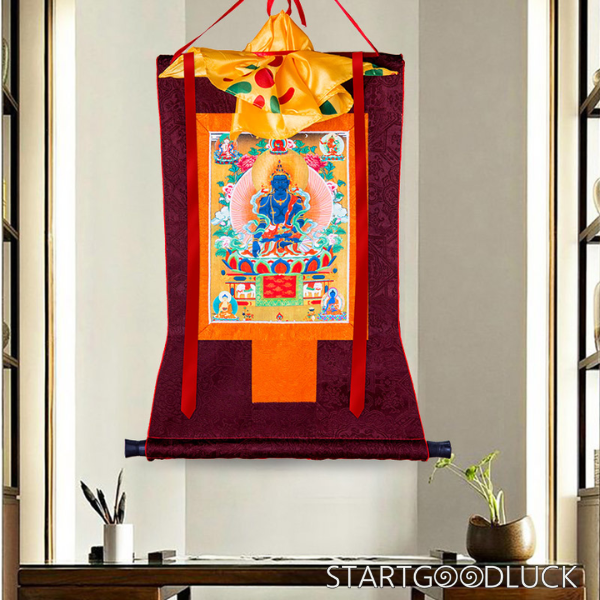This exquisite Thangka painting features Akshobhya (the “Unshakable Buddha”) seated on a lotus throne, crafted with traditional Tibetan embroidery. More than a decorative piece, this hand-embroidered Thangka is a sacred symbol of fearlessness and compassion in Tibetan Buddhism—revered as the “Lord of the Eastern Pure Land” who transforms anger into wisdom. It’s an ideal addition to spiritual home decor for Western art lovers and mindfulness seekers drawn to ethnic heritage.
Origin & Meaning of Akshobhya
Akshobhya is one of the Five Dhyani Buddhas, presiding over the Eastern Pure Land of “Wonderful Joy.” Born from a vow to never succumb to anger, he embodies the power to purify hatred and fear: Blue complexion: Symbolizes “unchanging dharma nature,” reflecting unwavering compassion. Mudras (hand gestures): The right hand in bhumisparsha mudra (“earth-touching”) dispels fear; the left hand in dhyana mudra (meditation gesture) holds a vajra, representing fearless wisdom. White elephant throne: Elephants signify strength—here, they represent conquering anger, considered the “most powerful defilement.” In Tibetan Buddhism, Akshobhya reminds practitioners to face challenges with calm resolve, turning frustration into spiritual growth.
Symbolism of the Embroidered Thangka
This Tibetan Thangka embroidery merges artistic craftsmanship with deep spiritual significance. Created with silk threads and gold accents, it showcases Akshobhya’s serene blue form against backdrops of lotus flowers (purity) and celestial clouds (spiritual elevation). Vibrant hues—crimson for courage, emerald for compassion—highlight traditional Tibetan needlework techniques (such as pingxiu and suoxiu) that create lifelike texture and sacred symmetry. For collectors, this Thangka is more than art—it’s a daily reminder of inner strength, the beauty of Tibetan cultural heritage, and the power to transform negativity into grace.

